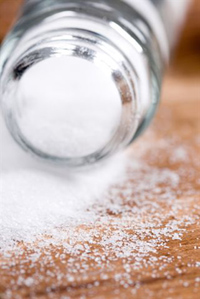What Is the Difference Between
Salt and Sodium?

Youíve probably noticed that many food labels list sodium as well as or instead of salt — this is because itís the sodium in salt thatís bad for you.
Sodium is a mineral or a metallic element, and symbolized by Na. It is considered as an essential nutrient, but like all things, too much sodium can be bad for you. Many people think of sodium to be coming mostly from salt, but in reality, sodium is practically everywhere. With salt or without salt, food items we consume may still have lots of sodium. Processed foods, sea foods, frozen and canned goods ó all of them contain sodium, which is more than enough for our dietary allowance. Overconsumption of sodium can be very bad for our health, as it can lead to hypertension and other cardiovascular diseases.
You need to make sure you know what youíre looking at — salt or sodium — and if a label only gives sodium, you can convert it into how much salt that food contains.
The amount of salt is the amount of sodium times 2.5, so a food that contains 1.5g of sodium per portion, has 3.75g of salt per portion — well on the way towards the recommended daily maximum of 6g!
|